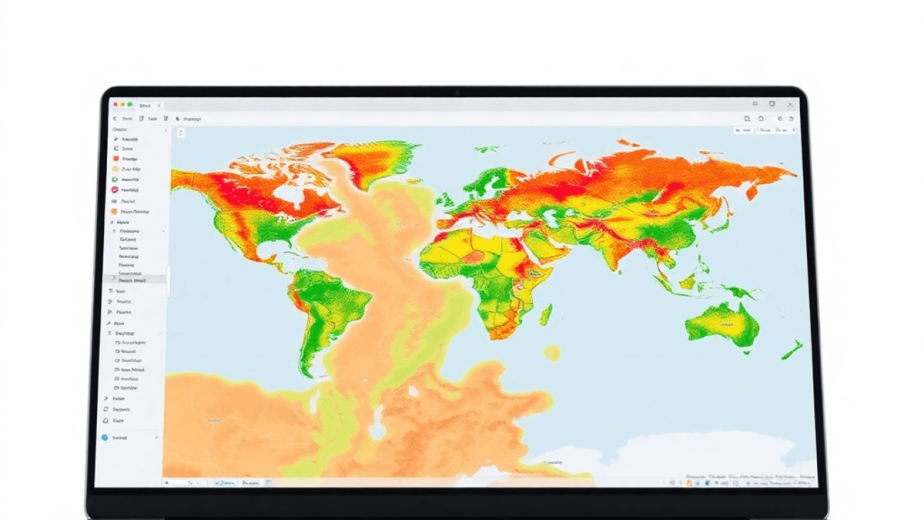Introduction
The use of drones has surged across various industries, transforming traditional practices with enhanced capabilities. In particular, drone pipeline inspections offer significant advantages over conventional methods.
Why Pipeline Inspections Matter
Regular monitoring is crucial for maintaining the integrity and safety of pipeline systems. Identifying potential issues early can prevent costly failures and environmental hazards.
This article explores the top benefits of inspecting pipelines with drones. Readers will discover how drone technology revolutionizes infrastructure management, highlighting key areas such as efficiency, cost-effectiveness, safety, and data quality. Understanding these benefits equips industry professionals with insights necessary for adopting advanced solutions in infrastructure monitoring.
1. Speed and Efficiency
Drones significantly enhance the speed of pipeline inspections compared to traditional methods.
- Fast Inspections: Drones can cover large areas in a fraction of the time it takes for ground crews. While manual inspections may require days or weeks, drones can complete similar tasks within hours.
- Operational Efficiency: The rapid assessment provided by drones allows for quick identification of issues such as leaks or structural weaknesses. This immediacy enables teams to implement maintenance strategies without unnecessary delays.
By leveraging drone technology, organizations can optimize their operational workflows, ensuring that pipeline integrity is maintained efficiently and effectively. The integration of UAVs not only accelerates inspection processes but also fosters a proactive approach to maintenance, ultimately enhancing overall pipeline management.
2. Cost-Effectiveness
The financial benefits of drones in pipeline inspections are significant. Traditional inspection methods often involve high operational costs due to:
- Labor Expenses: Manual inspections require large teams, increasing payroll and training costs.
- Equipment Costs: Heavy machinery and specialized vehicles add to the budget.
In contrast, drone inspections offer a more economical alternative:
- Reduced Operational Costs: Drones can cover extensive areas in a fraction of the time, decreasing the need for manpower and equipment.
- Long-Term Savings: With fewer personnel required on-site, companies experience savings in both labor and equipment maintenance.
By integrating drone technology into your infrastructure management strategy, you not only streamline operations but also enhance your bottom line through efficient resource allocation.
3. Enhanced Safety
Worker safety is the top priority in any inspection process, especially in dangerous environments. Manual inspections often put workers at significant risk, including:
- Exposure to harmful chemicals
- Navigating hazardous terrain
- Working at heights or near live equipment
Drones are changing the game for pipeline inspections by allowing access to these dangerous areas from a distance. This technology eliminates the need for workers to enter high-risk zones, greatly reducing the chances of accidents and injuries.
With drones, inspectors can conduct thorough assessments without putting themselves in danger. Advanced imaging technologies such as high-resolution cameras and thermal sensors are used to capture detailed data remotely.
The use of drone technology in pipeline inspections not only improves worker safety but also helps industries effectively manage risks. As companies prioritize health and safety, using drones for inspections becomes an important step in protecting personnel while still maintaining operational efficiency.
4. High-Quality Data Collection
Drones are equipped with advanced imaging technology that significantly enhances data accuracy during pipeline inspections. Key technologies include:
- High-Resolution Cameras: Capture detailed images, enabling the identification of surface anomalies.
- Thermal Sensors: Detect heat variations, crucial for identifying leaks or insulation failures.
- LiDAR (Light Detection and Ranging): Provides precise measurements and topographical data, essential for assessing infrastructure integrity.
The importance of detailed data cannot be overstated. Accurate information allows for effective leak detection and corrosion monitoring, leading to timely maintenance interventions. With the ability to gather vast amounts of high-quality data quickly, drones empower operators to make informed decisions about pipeline integrity. Leveraging this technology ensures that potential issues are addressed proactively, reducing the likelihood of costly repairs or environmental hazards in the future.
5. Access to Difficult Locations
Drones are excellent at reaching hard-to-reach places that traditional inspection methods find difficult to access. Their flexibility allows for efficient inspections in various challenging terrains such as:
- Mountainous regions: Inspecting pipelines that traverse steep slopes and rough landscapes, a task that would typically require extensive manpower and resources as outlined in this Army Field Manual.
- Swampy or marsh areas: Navigating through waterlogged environments without disturbing the ecosystem.
- Urban settings: Safely surveying infrastructure in crowded areas, reducing risks to human inspectors.
The ability of drones to operate in different environmental conditions enhances their effectiveness. They can handle tough weather, such as:
- High winds: Staying steady during inspections.
- Rain and snow: Having waterproof features, allowing for continuous monitoring regardless of precipitation.
Moreover, drones can be utilized for tasks similar to those done by construction helicopters in transmission line construction, making remote inspections more feasible. This not only simplifies access to these locations but also saves time and resources spent on manual checks. Consequently, this capability ensures pipeline integrity is maintained without compromising safety.
6. Predictive Maintenance Capabilities
Predictive maintenance is essential for managing the integrity of pipelines. It helps companies identify potential failures before they happen, leading to less downtime and lower repair costs.
How Drones Help with Predictive Maintenance
Drones play a vital role in this proactive approach by providing real-time data analytics. They offer valuable insights into the condition of pipelines, allowing teams to detect problems like leaks or corrosion at an early stage. This information empowers organizations to implement targeted maintenance strategies that address specific requirements.
Benefits of Using Drones for Predictive Maintenance
Here are some key advantages of utilizing drones for predictive maintenance:
- Timely data acquisition: Regular drone inspections facilitate continuous monitoring of pipeline conditions.
- Informed decision-making: Access to high-quality data enables better planning and resource allocation for maintenance tasks.
By incorporating drone technology into their operations, companies can improve their ability to uphold pipeline integrity while effectively optimizing their resources.
7. Ensuring Regulatory Compliance
Regulatory compliance is critical in pipeline management. Various standards exist to ensure safety, environmental protection, and infrastructure integrity. These include:
- Federal regulations: Agencies like the Pipeline and Hazardous Materials Safety Administration (PHMSA) enforce strict guidelines for pipeline inspections.
- State requirements: Local regulations may impose additional oversight depending on geographical considerations.
Regular drone assessments play a vital role in adhering to these regulatory standards. Drones facilitate:
- Consistent monitoring: Routine inspections provide up-to-date data, ensuring ongoing compliance.
- Documentation: Captured data can be easily organized and stored, supporting audit requirements.
Utilizing drones not only streamlines the inspection process but also strengthens compliance efforts. This technology ensures that operators stay ahead of regulatory demands, minimizing risks associated with non-compliance while enhancing overall operational efficiency.
8. Enhancing Emergency Response
Drones are crucial in emergency situations, especially during pipeline leaks or breaches. Their ability to respond quickly makes them invaluable for managing incidents effectively.
Key Benefits of Drones in Emergency Response
- Real-Time Data Collection: Drones can quickly capture high-resolution images and videos of the affected area, allowing teams to assess the situation without delay.
- Remote Monitoring: Accessing hazardous locations becomes safer, as drones eliminate the need for personnel to enter dangerous zones.
- Timely Decision Making: The swift delivery of data enables operators to make informed decisions rapidly, minimizing potential environmental damage and ensuring public safety.
- Comprehensive Coverage: Drones can cover large areas in a short time, providing a broader perspective on the incident than ground crews could achieve.
By integrating drone technology into emergency response plans, organizations can significantly improve their ability to prepare for and react to crises.
9. Environmental Safety Considerations
Prompt emissions detection is crucial for environmental protection. Drones play a significant role in identifying leaks and emissions, ensuring compliance with environmental regulations. Their ability to cover large areas quickly enables the timely discovery of potential issues that could lead to environmental harm.
Key benefits of using drones for emissions detection include:
- Precision Monitoring: High-resolution sensors can detect even the smallest leaks, providing data that is critical for maintaining pipeline integrity.
- Reduced Environmental Impact: By addressing leaks swiftly, companies can minimize their ecological footprint, promoting sustainable practices within the energy sector.
- Real-time Data Collection: Continuous monitoring allows for immediate action, preventing further contamination and supporting regulatory compliance efforts.
Drone technology not only enhances detection capabilities but also contributes to a safer and more responsible approach to managing pipeline infrastructure.
10. Integration of Advanced Technologies
The integration of advanced technologies like AI algorithms into drone inspections significantly enhances data analysis capabilities.
- Automated Processes: AI streamlines the inspection process by automating data collection and analysis, reducing human error and increasing efficiency.
- Advanced Analytics: Algorithms can identify patterns and anomalies in large datasets, providing insights that might be overlooked in traditional methods. This capability is crucial for detecting potential issues before they escalate.
Future advancements promise even greater improvements. The ongoing development of machine learning and AI can lead to:
- Enhanced predictive analytics, allowing companies to anticipate maintenance needs with greater accuracy.
- Improved imaging technologies, resulting in sharper visuals for better assessment.
As technology evolves, the role of drones in pipeline inspections will become increasingly sophisticated, offering more precise and actionable intelligence for infrastructure management.
The future of pipeline inspections technology in infrastructure management is set to be transformative, driven by advancements in drone capabilities. Key trends include:
- Increased Automation: As AI becomes more integrated into drone systems, automation will streamline inspections, reducing human intervention and improving accuracy.
- Data Analytics Evolution: Enhanced data analysis tools will provide deeper insights into pipeline conditions, leading to proactive maintenance strategies.
- Regulatory Adaptation: As regulations evolve, drones will play a crucial role in ensuring compliance through regular and precise inspections.
The top benefits of inspecting pipelines with drones include speed, safety, cost-effectiveness, and high-quality data collection. This combination not only enhances operational efficiency but also supports sustainable practices within the energy sector. Embracing drone technology is essential for future-proofing infrastructure management strategies and ensuring the integrity of pipeline systems.



